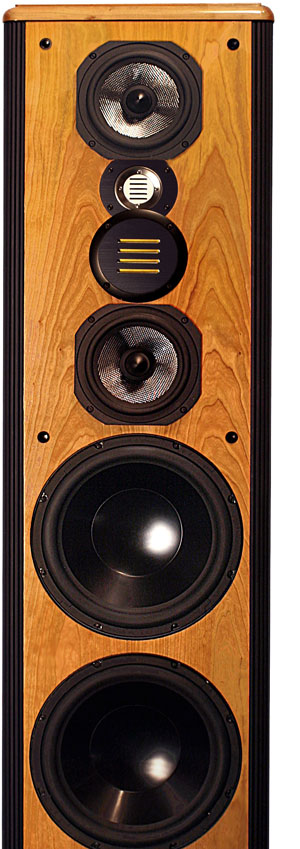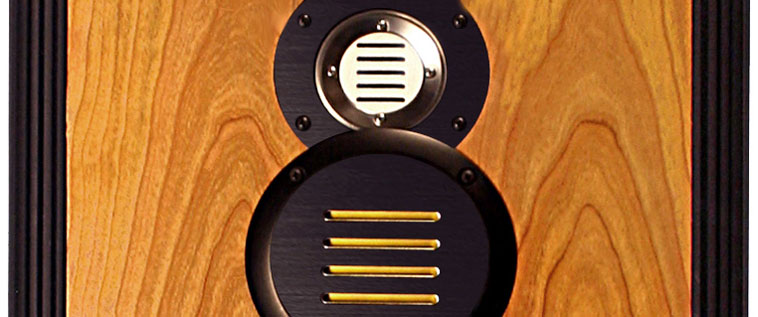 Why Was This Speaker Named Focus?
Why Was This Speaker Named Focus?
It is an acronym for “Field Optimized Convergent Source.” What it means is that the speaker is tuned for the actual listening position in a room, not to a 1-meter close-microphone measurements in an anechoic chamber.
Bill states that over a decade ago, he had learned that, “…the in-room power response painted a more accurate picture of what we were hearing from a loudspeaker than a simple curved spliced near-field measurement made at one meter distance.” He knew that reflections arriving at the listening position within 5msecs of the direct wave launch tonally influence the sound character, while 5-15msec reflections affect soundstage laterally, and 15-25msec reflections tell about the room the listener is in. Late reflections, beyond 25msecs, impede clarity of the source and become discrete echoes.
Applying this knowledge, the Focus HD is optimized to converge at the right place – approximately 3 meters from the front of the drivers, which happens to be the average listening distance! In addition, because of the wide frequency range of the silver graphite mid-bass drivers, four drivers per channel contribute in the bass pass-band. Bill explains: “…2 drivers are climbing in phase as frequency drops, while 2 drivers are falling in phase as frequency rises.” The result? It is impossible for floor reflections to “synch up” with both characteristics at four different physical distances, regardless of listening position. The real-world benefit is that the dreaded tonal shift from floor bounce in the upper bass and lower midrange is considerably reduced. The only people who will not benefit from this are those who are in the following criteria:
1. You have no floor in your listening room
2. Your listening position is less than four feet away
3. You already have stereo subwoofers
I guess that excludes nearly everyone. If you do meet these three criteria, I’d like to hear from you, as you must have some kind of rig! For the rest of us, the Focus HD is a bass lover’s dream come true.
One of the most important outcomes of Bill’s engineering degree from the University of Illinois was expertise in fluid dynamics, some aspects of which he says apply to air: “Air being a gas, offers resistance (impedance). The higher the acoustical impedance on a speaker diaphragm, the more effectively it can do work on the air.”
His distinctive designs incorporate not just average size drivers, but oversize drivers, and multiples of them! Bill’s tendency to see air propagation in fluid terms pays big dividends from my experiences with the HD’s. He relates that his largest speakers “display a large amount of piston area. This affords a more honest portrayal of the longer wavelengths with more uniform directivity.” His goal seems roughly to provide an inversely proportionate ratio of effective driver diameter to wavelength. He pointed out to me that a 10kHz wavelength is about one-inch long, but at 100Hz the wavelength stretches to more than 10 feet long. I loved his comment, “So where is the 10’ driver?” Fabulous! What an incredible thought: If you’ve got ten feet of wavelength, why not produce it with ten feet worth of driver surface?
I am not an engineer, but this sounds absolutely logical, though impractical. Bill acknowledges this readily: “It may be impractical for many, but I can assure you the benefit of the added piston area is quite audible for anyone with reasonable hearing.” I am both a reasonable person and someone who has experienced this phenomenon, and I assure you, dear reader, this man is onto something!
The Focus’ larger surface area of pistonic interactivity with the air as compared to what most high-end speakers manage to do is truly something to behold! In fact, much as the planar sound is unique and discernable from dynamic speakers, so I would assert that the “Legacy Large Pistonic Effect” is quite discernable to the ear and establishes it as unusually potent among floor standers. In many ways, Bill is taking a page from the planar speaker manufacturer’s play book. Fans of planars like the “wall of sound” they produce. Even though dynamic drivers, the sheer surface area of the combined drivers in speakers, like the Focus HD, combine to yield a very similar experience – a wall of sound that is very pleasing to hear.
To that end, the sheer size of the HD’s also comes into play. They are quite large for a speaker in the $6k+ range. Their midrange and tweeter arrays are almost a full foot higher than that of the Tannoy Glenair or Von Schweikert VR4 SR MkII. This physical location of the mid/upper frequencies elevated to such height makes them sound more like planar elements. When I first heard the HD, I liked it immediately. One reason was that the top-end was at what I thought was an appropriately realistic height. I am 6’5” tall, and most floor standers frankly are too low, causing me to have to “listen down” to them. They never seem to yield a truly full scale, lifelike impression of a band or singer because they’re too low! I had come to accept that this is just the way the world works, just as I cannot consider most import vehicles because they are made for standard heights. But, Legacy has elevated the art, or raised the bar, so to speak! When I listen to the HD’s, the presentation is at the appropriate elevation for recreation of a lifelike experience. (More on this in Manufacturer’s Comment. –Ed.)
Increasingly, as I become more acquainted with the universe of speakers, I absolutely adore the fact that the Focus HD has prodigious drivers, plenty of them – twin 12” woofers, twin 7” midranges, a 4” planar mid, and 1” neodymium tweeter! Now, that’s some surface area! Can it move the air? Oh, yeah! I’m not a big fan of concert or “live” level listening, but I can’t resist cranking up the Focus HD’s! They bring the house down when it comes to sheer presence, and the main reason is they have the means, the driver surface area, to get it done. I owned Vandersteen subwoofers with triple 8” drivers, but I found that the Focus HD operating much lower, in heavy duty subwoofer territory at the 16 Hz point, rendering the Vandy subs unnecessary.
Think of it, how many full-range speakers in the below $10k category are even scratching that depth, much less excavating bass well below 20Hz? It’s really not easy to switch out the Focus HD’s, knowing that I will miss the entire foundation of the low end. When I hear not just lots of bass, but deep, clean, low frequency bass, I find it hard to return to the more common 30-40Hz cut-off range.
This speaker was so inspiring to me that I coined some new terms to convey my listening impressions – among them the term “Dynastic” sound. Several speaker companies use variants of the word dynamic. However, I am specifically promoting dynastic for use in audio reviewing. What is dynastic sound? It is huge, formidable, cultured, intimate, enduring, dripping with wisdom and experience. The dynastic element to the Legacy Focus HD is that it presents such an overwhelmingly substantial sonic palate that one feels they would be missing out on a large part of the audiophile experience not to use them.
A few days before the arrival of the HD’s, my sons and I watched the 1986 Jean-Claude Van Damme movie Bloodsport, based on the life of Frank Dux, who represented the United States in martial arts and went undefeated in 369 fights! In the “big fight” scene, Van Damme’s antagonist tosses a narcotic powder into his eyes mid-fight, thereby blinding him. After being pummeled a few moments, Van Damme mentally returns to his earlier training in which he had to wear a blindfold and sense the approaching attacker. With his superlatively refined fighting sense, the sightless Van Damme dispatches his nemesis. As with so many martial arts movies, the underlying lesson was: It’s all about focus, getting your mind in the right place.
In audio manufacturing, it’s all about making a component that gets the listener’s mind in the right place. At a Chicago CES show years ago as he sat next to Bob Carver discussing what they felt were the most important qualities of a playback system, Bill heard Bob say, “I want to experience the sensation of someone sitting next to me and whispering in my right ear – then the soundstage would be truly realistic.”
- (Page 1 of 2)
- Next page →

